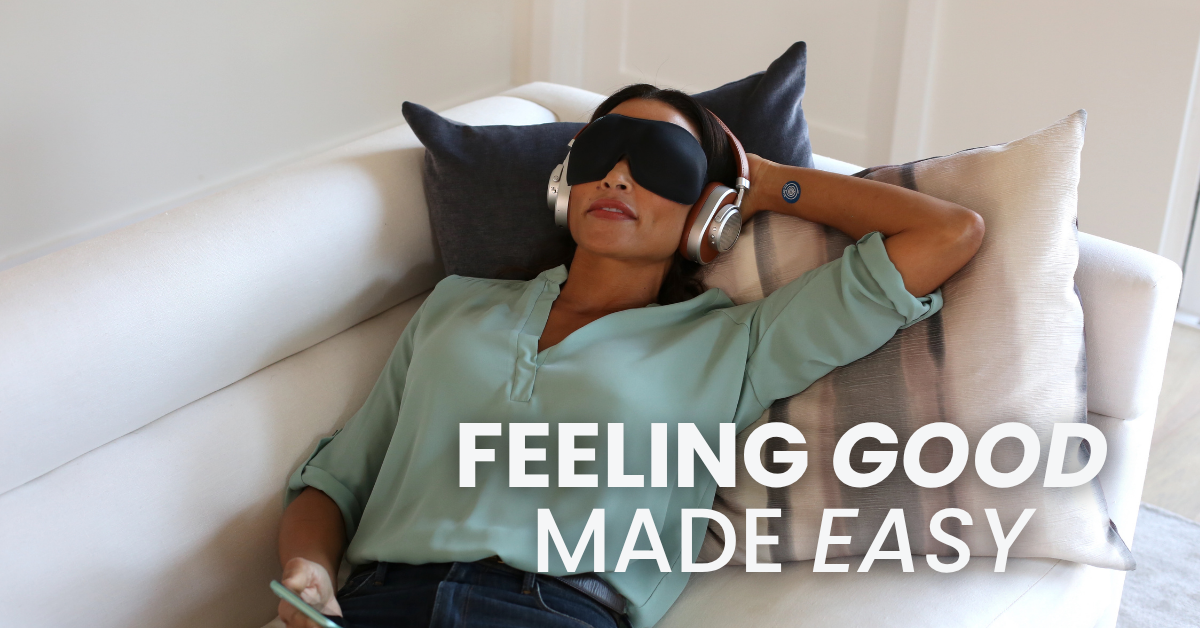
How Daylight Savings Impacts Sleep (and How to Reset Naturally with NuCalm)
Every year, millions of people feel the same thing when the clocks change: fatigue, grogginess, and disrupted sleep.
Daylight savings time (DST) isn’t just a small time shift, it’s a neurological event that temporarily throws off your body’s entire rhythm. Let’s unpack why your sleep struggles after daylight savings, what’s happening in your brain, and how to restore balance using neuroscience.
The Neuroscience of Sleep and Daylight Savings
Your body runs on a 24-hour internal rhythm known as the circadian rhythm. It regulates when you feel alert, when you feel tired, and how your body releases hormones like melatonin and cortisol. When daylight savings arrives, you lose or gain an hour, but your biology doesn’t instantly update.
The disruption in light exposure cues your hypothalamus, which controls sleep-wake timing. This sudden change can:
- Shorten your REM sleep cycles
- Spike cortisol levels in the morning
- Delay melatonin release at night
- Cause irritability, brain fog, and low mood
Research shows that after the time change, people experience increased daytime sleepiness, slower reaction times, and even a temporary rise in workplace and driving accidents. Your nervous system is trying to recalibrate, and until it does, your sleep quality suffers.
How NuCalm Helps Restore Sleep Balance
NuCalm works by guiding your brain into natural relaxation states that support circadian recovery.
It’s not another “sleep app”, it’s patented neuroscience that uses frequency-specific neuroacoustic software to calm the body’s stress response and restore balance.
Here’s how each NuCalm product supports your nervous system during daylight savings:
- Rescue: Stabilizes your parasympathetic system when your cortisol spikes after the time change. Perfect use anytime during the day.
- DeepSleep: Trains your brain into slow-wave and Delta frequencies to restore restorative sleep patterns and reduce the effects of “circadian jet lag.”
- PowerNap: Helps you recover lost REM and recharge mid-day when your sleep schedule is still adjusting.
- Focus: Keeps your mind clear during the day when sleep loss makes concentration harder.
- FlowState: Aligns brain wave patterns for creativity, easing the sluggishness that comes from poor sleep.
- Ignite: Re-energizes your mornings after “fall back,” helping you sync energy levels with the new light cycle.
Each product acts like a reset button for different stages of your daily rhythm, guiding your brain to where it needs to be at the right time.
Your NuCalm Plan for Sleep After Daylight Savings
To help your body adapt faster, here’s a simple neuroscience-based daily plan:
Morning:
If you wake up feeling tired - get back in bed and do a PowerNap (20 minutes) or a Rescue (20 - 120 minutes) to wake up feeling refreshed and energized.
Use Ignite (15 minutes) within 30 minutes of waking. The neuroacoustic pattern energizes your system and helps align your body clock with new morning light exposure.
Afternoon:
Use Focus or FlowState (20+ minutes) to offset mid-day dips in alertness caused by circadian misalignment. Both support sustained attention, boost creativity, and improve concentration.
Use Rescue (20 - 120 minutes) to restore and recalibrate by erasing your stress, anxiety and worries.
Evening:
Play DeepSleep (8 - 10 hours) as you fall asleep to help restore deep sleep cycles.
Optional: If you feel fatigue during the first few days, add a PowerNap (20 minutes) session mid-day to make up for lost rest without disrupting nighttime sleep.
This plan gently retrains your circadian rhythm and accelerates full adjustment, usually within 3–5 days.
Daylight Savings and Sleep: Key Facts
- Daylight savings ends November 2, 2025, at 2:00 a.m. in the U.S. (clocks “fall back” one hour).
- Most people need three to seven days to adjust.
- The U.K. changes a week earlier (October 26), and Australia and New Zealand adjust in April due to opposite seasons.
- Research confirms disrupted sleep efficiency, shorter REM periods, and altered hormone timing for up to a week post-shift.
- Using nervous system tools like NuCalm reduces these disruptions by restoring parasympathetic dominance faster.
Frequently Asked Questions About Sleep and Daylight Savings
Why can’t I sleep after daylight savings?
Your internal clock lags behind the external time. Even a one-hour shift alters melatonin release and sleep onset timing, creating temporary circadian misalignment.
How long does it take to adjust?
Most people normalize within three to seven days, though sensitive sleepers may take up to two weeks.
Does daylight savings affect sleep quality?
Yes. REM sleep often decreases, and cortisol remains elevated longer in the morning. That’s why you feel more tired even if you slept “enough” hours.
How does daylight savings affect my mood?
Reduced morning light and disrupted sleep impact serotonin and cortisol balance, contributing to irritability and mild mood dips.
Which daylight savings time gives you more sleep, spring or fall?
You technically gain an hour in fall (“fall back”) and lose one in spring, but your body’s adjustment is the harder part, not the number on the clock.
How can I fix my sleep naturally after daylight savings?
Get morning sunlight, avoid caffeine after noon, and use NuCalm’s Rescue and DeepSleep sessions to balance your nervous system and re-establish deep rest.
Can daylight savings affect my energy and focus?
Yes — circadian disruption lowers daytime alertness. Using Ignite, Focus, or FlowState helps restore brainwave balance and energy regulation.
How can I help my child adjust their sleep schedule?
Shift bedtime by 10–15 minutes nightly the week before the change and use calming cues (dim lights, quiet environment). Avoid screens before bed. Use DeepSleep on a speaker in their room at night to promote deeper, more restorative sleep.
Does everyone experience sleep problems during daylight savings?
Not everyone, but studies show over 60% of people report at least mild fatigue or sleep issues following the clock change.
A Simple Way to Reset Your Rhythm
Whether daylight savings continues or not, your body still runs on biology, not the clock.
When your nervous system is out of sync, every part of your life feels harder: focus, recovery, and mood all depend on how well you sleep.
By using NuCalm daily to guide your brain and body back into alignment, you can reset faster, sleep deeper, and wake up feeling clear, calm, and capable, no matter what the clock says.
Reclaim your balance with NuCalm.
Try NuCalm FREE for 7 days
NuCalm for Sleep
